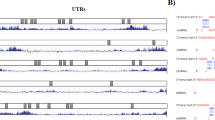Abstract
Increasing evidence indicates that miRNAs are involved in tumorigenesis of human renal cell carcinoma (RCC). However, the role of miR-206 is still unknown. This study aimed to investigate the possible mechanism of miR-206 in progression of RCC. Here, compared with adjacent normal renal tissues and HK-2 cells, miR-206 level was markedly decreased, whereas CDK6 level was obviously increased in RCC tissues and cell lines. MiR-206 was inversely associated with lymph node metastasis and TNM stage, and acted as an independent prognostic factor in RCC. MiR-206 effectively caused apoptosis and cell cycle arrest at G0/G1 phase, and affected the growth of xenograft tumor of nude mice. MiR-206 also inhibited migration and invasion of RCC cells by modulating the expressions of EMT-related genes. Dual-luciferase assay demonstrated CDK6 was a direct target of miR-206. CDK6 silencing aggravated the inhibition effects of miR-206. In conclusion, miR-206 suppresses proliferation and EMT of RCC by inhibiting CDK6 expression. The miR-206/CDK6 axis may provide a novel insight into tumorigenesis of RCC.





Similar content being viewed by others
References
Meyer AR, Carducci MA, Denmeade SR, et al. Improved identification of patients with oligometastatic clear cell renal cell carcinoma with PSMA-targeted 18F-DCFPyL PET/CT. Ann Nucl Med. 2019;33(8):617–23.
Patel HD, Puligandla M, Shuch BM, et al. The future of perioperative therapy in advanced renal cell carcinoma: how can we PROSPER? Future Oncol. 2019;15(15):1683–95.
Tabei T, Nakaigawa N, Kaneta T, et al. Early assessment with 18F-2-fluoro-2-deoxyglucose positron emission tomography/computed tomography to predict short-term outcome in clear cell renal carcinoma treated with nivolumab. BMC Cancer. 2019;19(1):298.
Todo M, Shirotake S, Nishimoto K, et al. Usefulness of implementing comprehensive pharmaceutical care for metastatic renal cell carcinoma outpatients treated with pazopanib. Anticancer Res. 2019;39(2):999–1004.
Bartel DP. MicroRNAs: target recognition and regulatory functions. Cell. 2009;136:215–33.
Ambros V. The functions of animal microRNAs. Nature. 2004;431:350–5.
Becam I, Rafel N, Hong X, et al. Notch-mediated repression of bantam miRNA contributes to boundary formation in the Drosophila wing. Development. 2011;138:3781–9.
Berindan-Neagoe I, Monroig PC, Pasculli B, et al. MicroRNAome genome: a treasure for cancer diagnosis and therapy. CA Cancer J Clin. 2014;64:311–36.
Rupaimoole R, Slack FJ. MicroRNA therapeutics: towards a new era for the management of cancer and other diseases. Nat Rev Drug Discov. 2017;16:203–22.
Wang Y, Tian Y. miR-206 inhibits cell proliferation, migration, and invasion by targeting BAG3 in human cervical cancer. Oncol Res. 2018;26(6):923–31.
Hao W, Luo W, Bai M, et al. MicroRNA-206 inhibited the progression of glioblastoma through BCL-2. J Mol Neurosci. 2016;60(4):531–8.
Jia KG, Feng G, Tong YS, et al. miR-206 regulates non-small cell lung cancer cell aerobic glycolysis by targeting hexokinase 2. J Biochem. 2019;167(4):365–70.
Wang Y, Tai Q, Zhang J, et al. MiRNA-206 inhibits hepatocellular carcinoma cell proliferation and migration but promotes apoptosis by modulating cMET expression. Acta Biochim Biophys Sin (Shanghai). 2019;51(3):243–53.
Dai C, Xie Y, Zhuang X, et al. MiR-206 inhibits epithelial ovarian cancer cells growth and invasion via blocking c-Met/AKT/mTOR signaling pathway. Biomed Pharmacother. 2018;104:763–70.
Ni Z, Shang X, Tang G, et al. Expression of miR-206 in human knee articular chondrocytes and effects of miR-206 on proliferation and apoptosis of articular chondrocytes. Am J Med Sci. 2018;355(3):240–6.
Pan BL, Tong ZW, Wu L, et al. Effects of microRNA-206 on osteosarcoma cell proliferation, apoptosis, migration and invasion by targeting ANXA2 through the AKT signaling pathway. Cell Physiol Biochem. 2018;45(4):1410–22.
Vergara D, Simeone P, Damato M, et al. The cancer microbiota: EMT and inflammation as shared molecular mechanisms associated with plasticity and progression. J Oncol. 2019;2019:1253727.
Boros É, Nagy I. The role of MicroRNAs upon epithelial-to-mesenchymal transition in inflammatory bowel disease. Cells. 2019;8(11):E1461.
Jiao D, Chen J, Li Y, et al. miR-1-3p and miR-206 sensitizes HGF-induced gefitinib-resistant human lung cancer cells through inhibition of c-Met signalling and EMT. J Cell Mol Med. 2018;22(7):3526–36.
Yin K, Yin W, Wang Y, et al. MiR-206 suppresses epithelial mesenchymal transition by targeting TGF-β signaling in estrogen receptor positive breast cancer cells. Oncotarget. 2016;7(17):24537–48.
Wang LS, Chen SJ, Zhang JF, et al. Anti-proliferative potential of glucosamine in renal cancer cells via inducing cell cycle arrest at G0/G1 phase. BMC Urol. 2017;17(1):38.
Logan JE, Mostofizadeh N, Desai AJ, et al. PD-0332991, a potent and selective inhibitor of cyclin-dependent kinase 4/6, demonstrates inhibition of proliferation in renal cell carcinoma at nanomolar concentrations and molecular markers predict for sensitivity. Anticancer Res. 2013;33(8):2997–3004.
Lin JA, Fang SU, Su CL, et al. Silencing glucose-regulated protein 78 induced renal cell carcinoma cell line G1 cell-cycle arrest and resistance to conventional chemotherapy. Urol Oncol. 2014;32(1):29.e1–11.
Author information
Authors and Affiliations
Corresponding author
Ethics declarations
Conflict of interest
The authors declare that they have no conflict of interest.
Ethical approval
The human study was approved by the Ethics Committee of Jinan Central Hospital Affiliated to Shandong First Medical University. All the RCC samples were collected with written informed consent in accordance with the Declaration of Helsinki. All experimental animal procedures in this study conformed to the National Institutes of Health Guide for the Care and Use of Laboratory Animals, and were approved by the Institutional Animal Care and Use Committee of Jinan Central Hospital Affiliated to Shandong First Medical University.
Additional information
Publisher's Note
Springer Nature remains neutral with regard to jurisdictional claims in published maps and institutional affiliations.
Rights and permissions
About this article
Cite this article
Guo, Z., Jia, H. & Ge, J. MiR-206 suppresses proliferation and epithelial-mesenchymal transition of renal cell carcinoma by inhibiting CDK6 expression. Human Cell 33, 750–758 (2020). https://doi.org/10.1007/s13577-020-00355-5
Received:
Accepted:
Published:
Issue Date:
DOI: https://doi.org/10.1007/s13577-020-00355-5




